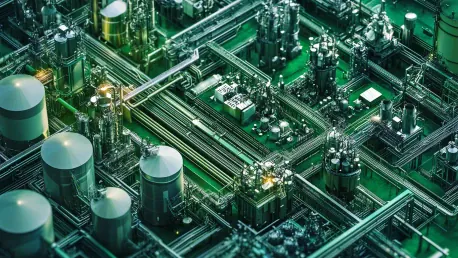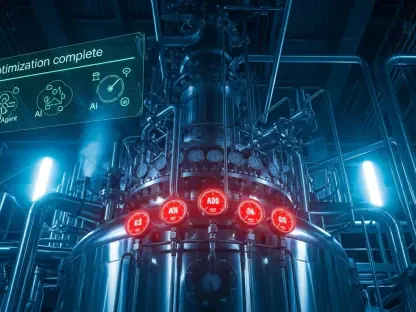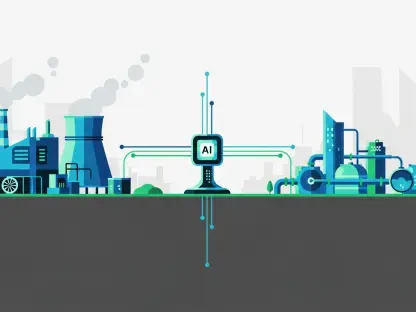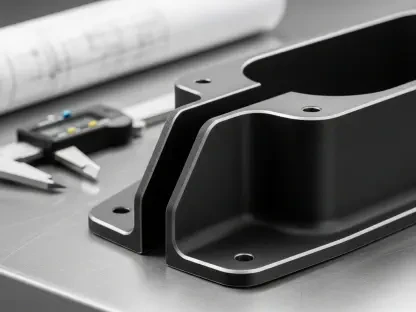The manufacturing industry is undergoing a significant transformation driven by the fusion of Artificial Intelligence of Things (AIoT) and a heightened focus on sustainability. These advancements promise not only to optimize operations but also to push the industry towards more eco-friendly practices. Understanding how these two elements are shaping the future of manufacturing is crucial for industry professionals and stakeholders.
The Power of AIoT in Modern Manufacturing
Revolutionizing Operations with AI and IoT
Artificial Intelligence (AI) combined with the Internet of Things (IoT) – collectively known as AIoT – is revolutionizing manufacturing operations on an unprecedented scale. This integration allows manufacturers to collect vast amounts of data from smart sensors and devices, analyze it in real-time, and make data-driven decisions. The result is enhanced efficiency, reduced downtime, and improved productivity, providing a substantial competitive edge. Data from connected devices enables predictive analytics, offering deeper insights and more precise control over production variables, thereby increasing the overall efficacy of manufacturing processes. AI algorithms can detect inefficiencies or potential malfunctions long before they become problematic, allowing for more streamlined operations and minimizing disruptions.
AIoT’s capabilities extend beyond automation within factories to encompass broader operational metrics. For instance, real-time analytics can optimize workforce management by predicting labor needs and adjusting staffing levels accordingly. By identifying areas where machine performance lags or resource overuse occurs, manufacturers can implement corrective measures swiftly. Additionally, AIoT systems utilize machine learning to continuously improve their predictive accuracy, refining operational efficiency over time. Through these advanced technologies, manufacturers can significantly reduce operating costs while enhancing their capacity to meet production demands reliably and consistently.
Predictive Maintenance and AIoT
One of the most critical applications of AIoT in manufacturing lies in the realm of predictive maintenance. Traditional scheduled maintenance, while useful, often leads to unnecessary downtime and costs due to its periodic nature. However, AIoT introduces a paradigm shift by enabling continuous monitoring of equipment health through interconnected sensors and intelligent algorithms. This system predicts equipment failures before they occur, allowing for timely intervention and maintenance, improving reliability, extending the lifespan of machinery, and enhancing financial performance by reducing repair costs and minimizing the risk of unexpected breakdowns.
Implementing predictive maintenance using AIoT involves sophisticated data analytics to gauge equipment performance metrics like vibration, temperature, and load. These metrics are analyzed to detect patterns and anomalies indicative of potential failures. Machine learning models are continuously trained on this data, refining their predictive capabilities and enhancing their accuracy. Consequently, maintenance can be performed precisely when needed, avoiding the pitfalls of both over- and under-maintenance. This proactive approach reduces equipment downtime, preserves the integrity of the production schedule, and fosters a more resilient and cost-efficient manufacturing operation.
Enhancing Supply Chain Management
AIoT plays a pivotal role in optimizing supply chain management, transforming it into a highly efficient and responsive ecosystem. Real-time data collection from connected devices, combined with sophisticated AI algorithms, can predict demand trends, optimize inventory levels, and ensure timely deliveries. This capability to anticipate market demands and respond swiftly leads to a more streamlined supply chain, which reduces waste, lowers costs, and enhances customer satisfaction. By leveraging AIoT for supply chain management, manufacturers can achieve a higher degree of precision and agility in their operations, ultimately fostering a more sustainable and customer-centric approach.
AIoT enhances visibility across the supply chain, allowing manufacturers to track the movement and condition of goods from production to delivery. Such transparency is crucial for identifying bottlenecks, inefficiencies, or potential risks within the supply chain network. By analyzing data on transportation routes, weather conditions, and supply chain disruptions, AIoT systems can recommend alternative strategies to mitigate delays and optimize logistics. Additionally, predictive analytics can forecast inventory requirements based on historical data and market trends, ensuring that manufacturers can maintain optimal stock levels without overproduction or stockouts. This alignment of supply with demand not only drives efficiency but also supports sustainable manufacturing practices by minimizing resource and energy waste.
Sustainability in Manufacturing
The Drive Towards Decarbonization
Sustainability has become a critical consideration for manufacturers worldwide, driven by both regulatory pressures and growing environmental awareness. One of the major focuses is on decarbonization, which entails reducing carbon emissions across the manufacturing process. By adopting green technologies and practices such as renewable energy, energy-efficient equipment, and carbon capture mechanisms, manufacturers can significantly cut down their carbon footprint. This shift not only helps in addressing climate change but also aligns with global sustainability goals, thereby enhancing the industry’s reputation and compliance with international environmental standards.
Incorporating renewable energy sources like solar, wind, and hydroelectric power helps manufacturers reduce their reliance on fossil fuels, thereby lowering greenhouse gas emissions. Efficacious energy management systems, powered by AIoT, track energy consumption in real-time and optimize the use of renewable resources. Additionally, upgrading to energy-efficient machinery and equipment can further reduce energy consumption and operational costs. Carbon capture technologies are also gaining traction, enabling manufacturers to offset emissions by capturing and storing carbon dioxide generated during production. Collectively, these efforts contribute to a sustainable manufacturing ecosystem that proactively mitigates its environmental impact.
Circular Economy and Zero Waste Initiatives
Implementing circular economy models is another significant trend reshaping the manufacturing industry. The primary objective of this approach is to minimize waste and maximize the use of resources by creating a closed-loop system where products are designed, used, and then returned for reuse, refurbishing, or recycling. This model contrasts sharply with the traditional linear economy, which follows a take-make-dispose pattern. Companies are investing in technologies and processes that facilitate material recovery and reuse, aiming to achieve zero waste to landfill. These efforts contribute to environmental preservation, resource conservation, and significant cost savings over time.
The circular economy framework encourages manufacturers to rethink product design and lifecycle management. Product designs prioritize durability, reparability, and recyclability, ensuring that components can be easily disassembled and repurposed. Advanced recycling technologies enable the efficient recovery of valuable materials from end-of-life products, reducing the need for virgin resources. By integrating AIoT, manufacturers can track and manage material flows more effectively, optimizing the use of recycled content and reducing waste generation. Additionally, circular economy practices align with consumer expectations for sustainable products and can open new revenue streams through innovative business models like product-as-a-service, fostering a more resilient and sustainable manufacturing sector.
The Role of Smart Buildings in Sustainable Manufacturing
Smart building technologies are instrumental in achieving sustainable manufacturing goals, offering a range of solutions to optimize energy use and reduce waste. These technologies encompass advanced HVAC systems, energy-efficient lighting, and automated controls that intelligently manage resource consumption. By leveraging IoT sensors and AI analytics, smart buildings can monitor environmental conditions, adjust systems dynamically, and predict maintenance needs, leading to significant energy savings and enhanced operational efficiency. Creating more energy-efficient and sustainable manufacturing facilities not only lowers operational costs but also helps meet regulatory sustainability targets and improves overall corporate social responsibility.
Advanced HVAC systems designed for smart buildings utilize AI algorithms to optimize heating, ventilation, and air conditioning based on real-time occupancy and environmental data. This dynamic adjustment reduces energy waste and enhances indoor air quality, contributing to a healthier work environment. Similarly, energy-efficient lighting systems, controlled by IoT sensors, adjust brightness according to ambient light levels and occupancy patterns, further reducing energy consumption. Automated controls extend to water management, waste management, and other resource-intensive processes, ensuring optimal utilization and minimal waste. By integrating these technologies, smart buildings support manufacturers in their pursuit of sustainability, aligning operational practices with broader environmental goals.
Strategic Business Insights
Navigating Economic and Political Uncertainties
Manufacturers today face a multitude of uncertainties stemming from economic fluctuations and political shifts, such as changes in trade policies, tariff regulations, and geopolitical tensions. Navigating these uncertainties requires a strategic focus on resilience, agility, and continuous improvement. By leveraging AIoT, manufacturers can obtain real-time insights into various aspects of their operations, empowering them to make informed and adaptive decisions. This capability is crucial for maintaining stability and growth in the face of unpredictable external forces, helping companies remain competitive and responsive to changing market conditions.
AIoT enhances the ability to monitor global supply chains, track economic indicators, and assess the impact of political developments on manufacturing operations. With real-time data and predictive analytics, manufacturers can anticipate potential disruptions, adjust production schedules, and align their sourcing strategies accordingly. This proactive approach mitigates risks and ensures continuity in supply chain operations. Additionally, AIoT supports workforce management by predicting labor needs, optimizing operational efficiency, and facilitating remote monitoring and management of manufacturing processes. In an era of economic volatility and political uncertainty, these capabilities enable manufacturers to adopt a resilient and adaptive stance, safeguarding their operations and fostering long-term growth.
Cloud-Based Solutions and Data Security
The adoption of cloud-based solutions, such as Electronic Data Interchange (EDI), is becoming increasingly important for modern manufacturing. These solutions offer enhanced agility, accuracy, and security for managing vast amounts of data generated during manufacturing processes. By migrating to the cloud, manufacturers ensure that their data is securely stored and quickly accessible, facilitating better decision-making, real-time collaboration, and improved compliance with data protection regulations. Cloud-based platforms also provide scalability, allowing manufacturers to expand their digital capabilities as needed without the constraints of traditional IT infrastructure.
Cloud-based EDI solutions enable seamless integration and exchange of business documents, such as purchase orders and invoices, between trading partners. This automated data exchange reduces manual errors, accelerates transaction processing, and enhances supply chain efficiency. Cloud-based platforms also leverage advanced security protocols, including encryption and multi-factor authentication, to protect sensitive data from cyber threats. The inherent flexibility of cloud solutions allows manufacturers to adapt quickly to evolving business needs, deploying new applications and services with minimal disruption. By embracing cloud-based technologies, manufacturers can drive digital transformation, streamline operations, and maintain robust data security, positioning themselves for success in an increasingly digital and interconnected world.
Financial Optimization Through Technology
Predictive maintenance powered by AIoT is not only an operational boon but also a significant financial advantage for manufacturers. By reducing unexpected equipment failures and optimizing maintenance schedules, manufacturers can achieve substantial cost savings and minimize costly downtime. Implementing AIoT-driven predictive maintenance strategies translates to lower repair expenses, extended equipment lifespan, and higher overall operational efficiency. These financial benefits underscore the importance of investing in advanced technologies that enhance reliability and profitability, contributing to business sustainability and long-term competitiveness.
AIoT systems use data from connected sensors to monitor the condition of equipment continuously, providing early warnings of potential failures. This proactive approach enables maintenance teams to address issues before they escalate, preventing costly breakdowns and production halts. Predictive analytics also optimize maintenance schedules, ensuring that interventions occur at the most opportune times, balancing the need for upkeep with minimal disruption to operations. The financial implications of such precision are significant, as manufacturers can allocate resources more effectively, reduce inventory costs for spare parts, and improve asset utilization. By integrating AIoT into their maintenance strategies, manufacturers can achieve a robust return on investment, driving financial optimization and operational excellence.
Educational and Collaborative Efforts
Fostering Innovation Through Collaboration
Collaborative initiatives, such as the NVIDIA AI Tech Community in Pittsburgh, play a crucial role in fostering innovation within the manufacturing sector. Partnerships between educational institutions, technology companies, and manufacturers facilitate the sharing of knowledge, resources, and expertise, accelerating the development and adoption of advanced technologies. These collaborations create a dynamic ecosystem where stakeholders can explore cutting-edge solutions, address industry challenges, and drive technological advancements that enhance manufacturing processes and outcomes. As a result, fostering innovation through collaboration becomes a cornerstone of the industry’s future growth and competitiveness.
Educational institutions contribute vital research capabilities and a pipeline of skilled talent, while technology companies provide the tools and platforms necessary for developing and deploying AIoT solutions. Manufacturers benefit from direct access to innovative technologies and practices, enabling them to stay ahead of industry trends and improve operational efficiencies. Collaborative efforts often result in the creation of technology centers, incubators, and pilot projects that showcase practical applications of AIoT in manufacturing. These initiatives not only drive technological progress but also promote a culture of continuous learning and adaptation, ensuring that the manufacturing industry remains agile and resilient in a rapidly evolving landscape.
Scaling AI Adoption Across Enterprises
The manufacturing industry is currently experiencing a remarkable transformation, largely propelled by the integration of Artificial Intelligence of Things (AIoT) and a growing commitment to sustainability. This fusion is set to redefine traditional manufacturing processes, ushering in an era where operations are not only highly optimized but also significantly more environmentally responsible. AIoT technologies enable better monitoring, predictive maintenance, and automation, which collectively enhance efficiency and reduce waste. At the same time, there’s a heightened focus on sustainable practices, such as using renewable energy sources, recycling materials, and minimizing carbon footprints. Industry professionals and stakeholders must closely follow these developments as understanding the intersections of AIoT and sustainability will be key to staying competitive and meeting future regulatory and consumer demands. Overall, these advancements represent a pivotal shift, promising a future where manufacturing is smarter, greener, and more sustainable than ever before.









